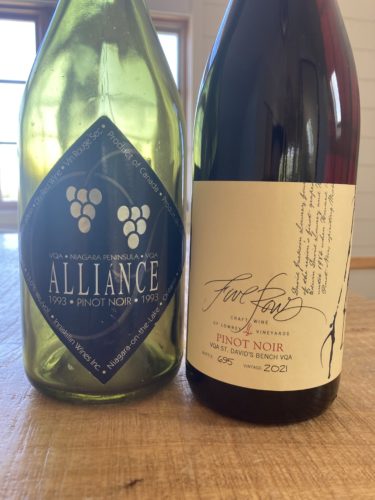
2021 Pinot Noir
The 2021 growing season, and the red wines that resulted, are a study in contrast and perseverance. In my vintage notes for the 2021 Pinot Noir there is written but one telltale comment, “One of those years.”
As a varietal Pinot Noir presents inherent contradictions. In the vineyard, it is a grape that requires intense labour, constant attention and a heavy hand, at times, to properly manage the canopy. In the winery, conversely, I’ve come to learn that restraint, patience and a gentle approach are critical to successfully translating terroir.
So that is why, given the difficult fall conditions of 2021, I took a different attitude toward crafting my Pinot Noir. Instead of lamenting the breakdown of clusters and writing off the vintage, I took the long view. Past vintages (and wiser winemaking colleagues than I) have taught me that the final sprint to cut out all of the rotten clusters and berries is not the end of the game, but actually just the end of the first half. I’ve been witness to many great late-game comebacks in my life, mostly against my rooting interest, but this could represent a moment of redemption!
So it was with guarded optimism that we harvested our Pinot Noir on September 21st, surely to get them off before the next imminent downpour. The ripening parameters were to my liking, but the field was soaked and my time was limited to cull out as much rot as possible prior to the handpick. I conjured up my best Edward Scissorhands, minus the Johnny Depp looks, and set to work.
Once the fruit was picked, sorted and gently destemmed into one tonne bins, they were sealed for a four-day cold soak. It is normally my hope that the wild fermentations would kick off right after the fourth day, but that is rarely the case. Thankfully, in this instance the stars seemed to align and when I cracked the bin lids on day four, I was greeted with a nice firm cap of skins and whole berries and the wonderful smells of a burgeoning fermentation. We were off to the races; the comeback was afoot!
Indigenous yeast fermentations can be a wild ride at times, but those driving the 2021 Pinot bins were models of consistency and aromatic beauty. Must temperatures hovered around 20C and peaked at 32C, and the bins were dry in seven days.
The bins were lightly pressed, then racked into five French oak barrels. This is where the restraint and patience are put into practice. Aside from the odd tasting session and biannual racking, there is not much to do over the next two years providing the wines are sound.
The final barrel tasting and blending sessions are the make or break moment when everything is on the line. So many combinations, so many possibilities, it can send your mind in many different directions. Some wines, however, present clarity in those moments and that was the case for the 2021 Pinot. It ended up being “one of those years” when the cooperage variables of barrel age, forest, grain tightness and toast level all line up in sync with the wine. The result is a wine that stars the terroir, while the oak and the winemaker play the supporting role.
Sometimes you just have to trust that the vineyard can be the hero in the end.


